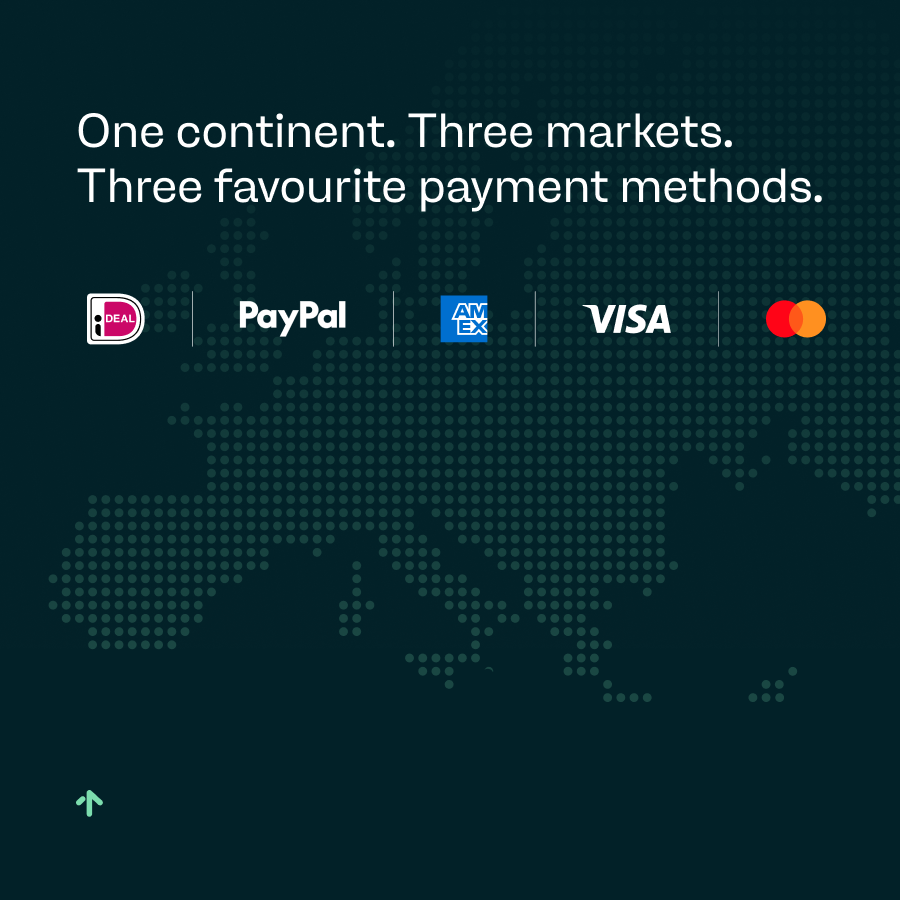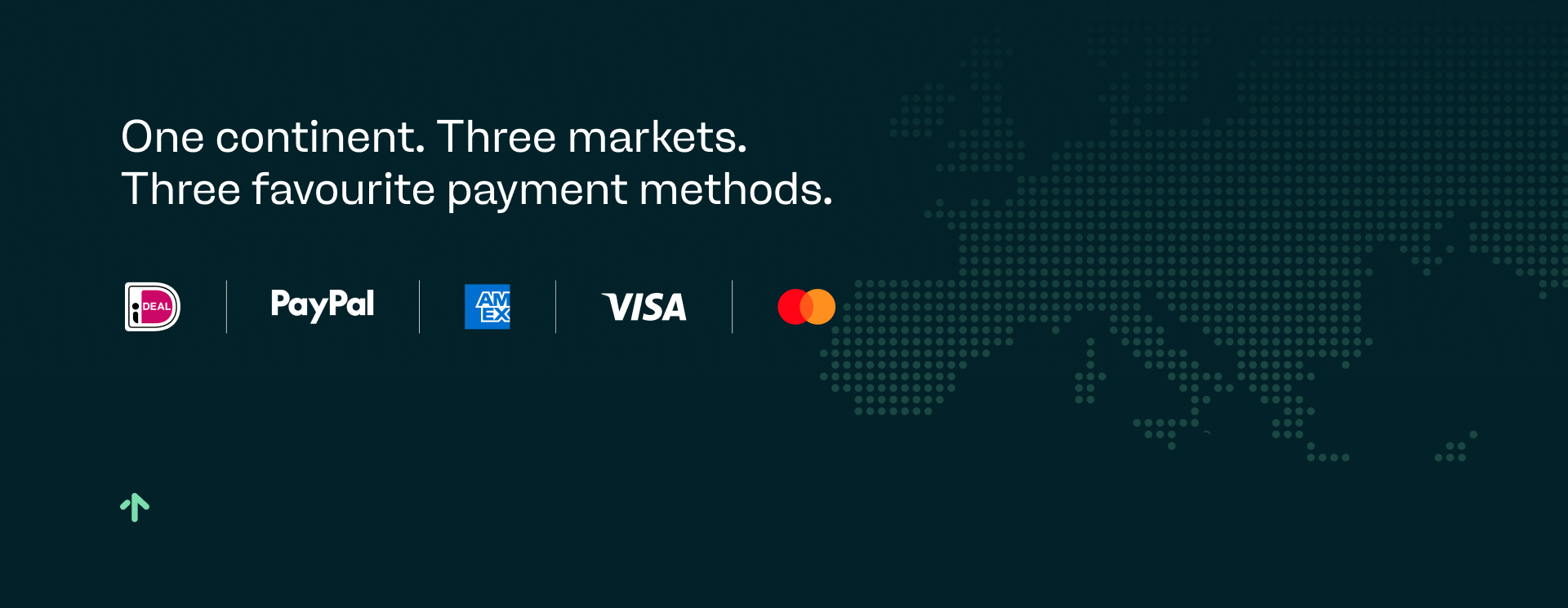
When it comes to the world of shopping, preferred payment methods play a crucial role in shaping consumer experiences. Merchants must ensure they are providing the right payment options for any given market, and avoid the ‘one-size-fits-all’ trap. Our new report highlights the need for European merchants to ensure they are offering a variety of payment options, tailored to regional preferences, and emphasising benefits such as security and convenience.
One continent. Three markets. Three favourite payment methods.
To help merchants better understand evolving consumer sentiment, payabl. commissioned an extensive pan-European survey of shoppers, delving into both online and offline behaviour to discover what people now expect from the checkout experience. Our subsequent report underlines the need for diversity when curating the payment options present at your checkout.
When it comes to online shopping, PayPal is the most common payment method overall, with one in two respondents telling us it’s their preferred way to pay.
"PayPal provides a streamlined, user-friendly experience. It’s easy to use, it’s quick, and it’s into many online platforms. Also, PayPal's focus on policies and practices enhances its perception of security beyond the mere hiding of bank and card details that reduces the perceived risks associated with sharing financial details online, a significant advantage for security-conscious consumers." David Birch, Global Ambassador, Consult Hyperion
There are three key reasons that explain why PayPal is so popular among European consumers. Firstly, it’s been a prominent player in the online payment space since its inception in 1998, making it a familiar, recognisable, and trusted brand.
Secondly, PayPal provides a streamlined, user-friendly experience. It’s very easy to use, it’s quick, and it’s integrated into many online e-commerce platforms. And thirdly, PayPal’s focus on buyer protection policies and fraud prevention practices enhances its reputation with security-conscious consumers.
PayPal is particularly popular in Germany, with nearly three-quarters (71%) of respondents to our survey putting it in first place. Unsurprisingly, the number of German websites offering PayPal as a payment method is significantly higher than those from other countries.
However, the picture starts to change when you cross borders.
In the UK, for example, debit cards are still seen as the preferred payment method (63%), while in the Netherlands, local online payment method iDEAL (39%) edges out PayPal (35%) as the nation’s favourite. Around 1.3 billion transactions are now processed through iDEAL annually, accounting for 73% of all Dutch online purchases.
The most common reasons for consumers selecting their preferred payment method are speed (46%), convenience (44%), and security (41%). Interestingly, a payment method being widely accepted, or simply using a method out of habit, were less common drivers for selecting particular purchase methods.
This suggests that payment method selection is an active choice by consumers, not simply based on familiarity. Choosing a payments partner with an extensive suite of payment methods and local market expertise can help you provide the best selection of trusted and locally preferred payment options – a key factor in customer retention and conversion.
Preferred payment methods online vs offline
More than six in ten (64%) consumers say they use a different payment method when shopping in-store, which again validates the idea they are making an active choice over what payment method they are using and aren’t just creatures of habit.
For those choosing to use a different payment method in-store, cash was the most popular option, with 60% of respondents stating it’s their preferred payment method. There were some regional differences, with 67% of German respondents ranking cash as their top preference, compared with 58% in the Netherlands and 57% in the UK.
Even though the “death of cash” is often overstated, with the European Central Bank reporting that more than half (52%) of point-of-sale (POS) payments in the euro area were made using cash in 2024, this is still a noticeably high result. This desire to deal in cash for some purchases shows you need to provide diverse payment options that cater to different shopping environments and needs.
Consumers value payment flexibility. Despite the rise of digital payment options, they want the freedom to choose the method that best suits the context of their purchase, whether it’s the familiarity of cash or the convenience of mobile wallets.
An appetite for new flavours
While it’s essential to support the payment methods your customer expect, there’s also an opportunity to promote other payment options by highlighting their benefits, such as speed and security, to encourage their adoption across both online and in-store channels.
The good news for retailers keen to promote new payment methods is that consumers are also very willing to try them out. Our research reveals only 7% are entirely unwilling to switch to a new payment method. And almost a third of respondents are willing to switch to a new payment method if it means the checkout process is faster.
One payment method that consumers are increasingly turning to is Buy Now Pay Later (BNPL), with BNPL services second to a credit card when it comes to making high-value purchases. Consumers like the flexibility to spread the cost over time, making larger purchases more manageable. The BNPL market in Europe is expected to grow by 12.4% on an annual basis to reach $191.3 billion in 2025, underlining its fast-growing appeal to consumers.
For those consumers willing to try new alternative payment methods, incentives – such as discounts, cashback, and loyalty programmes – are most likely to sway them.
Ultimately, to succeed in today’s competitive e-commerce ecosystem, you need to offer a variety of payment options, tailored to regional preferences, and make sure you emphasise benefits like security and convenience. Incentivising any new payment methods that appear at your checkout with rewards or highlighting their advantages will help boost adoption.
Flexibility in payment methods for both in-store and online shopping is crucial for meeting consumer needs and staying ahead of the game.
Download ‘The state of European checkouts: Consumer expectations, payment preferences, and security insights’ to find out more about the continent’s preferred payment options.
